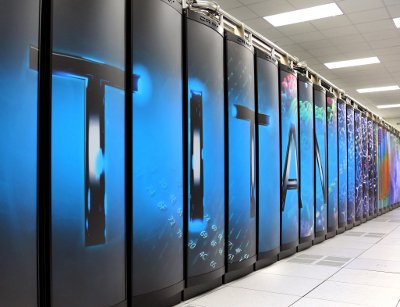Titan, the supercomputer that was awarded the number-one spot on the list of the world’s most powerful supercomputers Monday, was the result of a metamorphosis of its predecessor Jaguar. While being 10-times more powerful that Jaguar, Titan uses only 19% more power than its previous incarnation.
The supercomputer – belonging to the US Department of Energy’s (DoE’s) Oak Ridge National Laboratory (ORNL) in Oak Ridge, Tennessee – owes its energy efficiency gain to an atypical architecture, which uses graphics processing units (GPUs) to accelerate performance. GPUs – originally created to make video games run better – are slower than CPUs, but they can handle hundreds of calculations simultaneously, according to ORNL.
Titan, a Cray XK7 system, still has about 300,000 CPU cores, which it uses to guide simulations. But every node with a 16-core AMD Opteron 6200-series processor also has an Nvidia Tesla K20X GPU accelerator, doing the “heavy lifting”.
To get to the top of the new Top500 list (the regularly updated list of 500 most powerful computers), the system reached a speed of 17.59 petaflops. Theoretically, it can reach 27 petaflops (or 27 quadrillion calculations per second) using about 9MW of electricity.
Titan shares a data center with other supercomputers in a building designed to handle 25MW of power. Buddy Bland, project director of ORNL’s Leadership Computing Facility (the data center), said the facility’s electrical infrastructure had to be upgraded to accommodate the increase in power Titan required.
“We added an additional 3MW transformer to our facility and put in some additional switchboards,” he said.
Cooling did not need to be upgraded since the existing cooling system’s capacity had enough headroom to absorb the jump in demand. Titan consists of the same amount of racks as Jaguar did, cooled by the same EcoFlex liquid-cooling system by Cray.
ORNL does not keep Titan on uninterruptible power supply (UPS). “Titan is not on UPS,” Bland said. “It doesn’t have to be. We don’t have a mission requirement that it never go down.”
There is about 1.5MW of UPS capacity in the building, however, to ensure that Titan’s 10-petabyte storage system does not go down. “That’s 10,000 drives. You don’t want all of those things crashing down.”
Also on UPS are the lab’s IT infrastructure and its network equipment. The network gear has a mission-critical uptime requirement since the lab serves as a hub for the DoE’s Energy Sciences Network (ESnet), which links other national laboratories, universities and research institutions.
Opportunities for this power-protection system to shine are rare, however. Since the lab was built in the early 1940s as part of the Manhattan Project, it has very robust utility infrastructure around it.
During the atomic-weapon-development project, the lab was home to a nuclear reactor that was used to demonstrate extraction of plutonium from enriched uranium.
Losing power to the site would have meant a several-month-long set-back for the project, Bland said. “And so the utility infrastructure was always designed to be extremely robust and have an enormous amount of power.”

